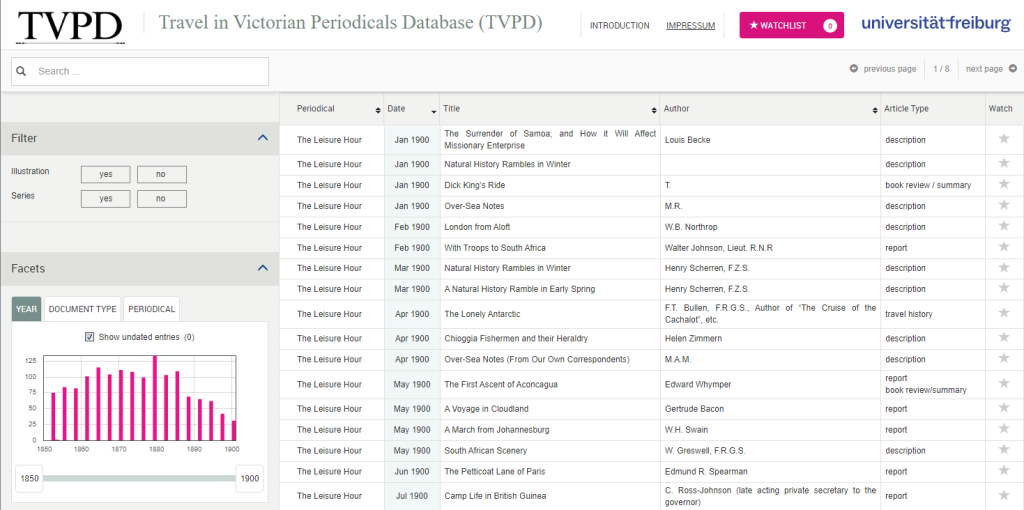
Die „TVPD“ ist aus einem Forschungsprojekt an der Uni Freiburg hervorgegangen:
Victorian travel writing has been extensively studied for books, but the representation of travel in periodicals – in the form of travelogues, topographical descriptions and travel advice, in lengthy articles as well as short notes – has received little attention. It can be claimed, though, that periodicals had a greater impact on the Victorian culture of travel than books because they were a medium of daily life, addressed different sections of society, and engaged with travel in media-specific forms. With their own media logic, Victorian periodicals played a major role in accommodating their readers to the discourses and practices of contemporary travel.
The database focuses on four widely read periodicals:
- The Leisure Hour (1852–1905) was a long-lived and influential family magazine with a great number of travel-related articles. During its first two decades, the Leisure Hour’s address encompassed readers of the middle as well as the working classes.
- Good Words (1860–1910) was a family magazine addressed to middle-class readers. Like the Leisure Hour it cultivated a Protestant tone.
- The Englishwoman’s Domestic Magazine (1852–1882) was addressed to middle-class female readers and situated travel in the middle-class female lifeworld, also reflecting the cultural constraints to which women’s travel was exposed.
- The Boy’s Own Paper (1879–1967) was targeted at young male readers. Its engagement with travel was embedded in an environment of fiction and non-fiction preoccupied with masculine adventure and athleticism.
The entries in the database show that these periodicals had different travel profiles, i.e. they represented travel with different frequencies and with different biases, depending on the interests of their owners and editors and those of the audiences they primarily addressed. These travel profiles also changed over time, reflecting, for example, how certain travel destinations and modes of travel became unfashionable and were replaced by others.
The database operates with intervals for each periodical, and it is possible to compare the periodicals by year of appearance.
For each single item, the database gives bibliographical data and a brief summary of content. It is noted whether an item is illustrated or not, and whether it is part of a serial or series. Serialisation enabled periodicals to publish long travelogues, but it is an asset of periodicals that the ‘small’ form of the single article allows description of minor kinds of travel that are rarely depicted in the form of the book.
Items are further categorised for their dominant mode of representation: a major distinction is that between report, i.e. narrative representation, and description, mostly place description. Other items offer travel-related advice, deal with the history of travel or present the biography of a traveller. One should keep in mind, though, that modes of representation are frequently mixed.
Categorisation of items according to geographical region is similarly complex due to changing historical, political and socio-cultural circumstances. The classification in the database is therefore broad, but it gives a first indication of the major regions of travel during the Victorian period and how they were associated with specific kinds of travel. Precise locations are named in the content descriptions of the respective items.
